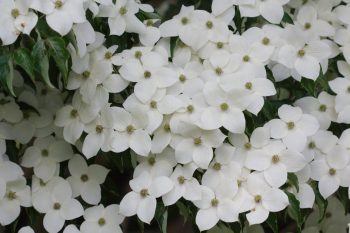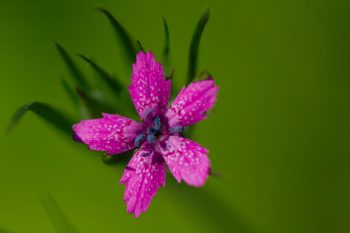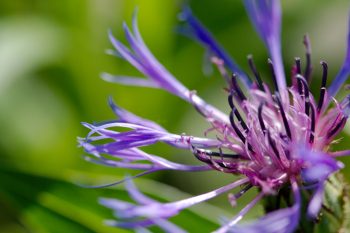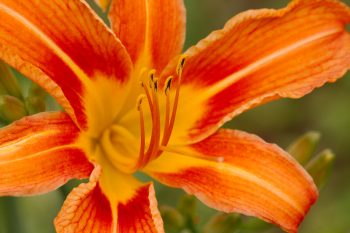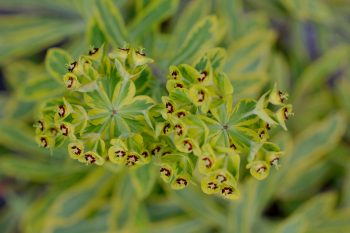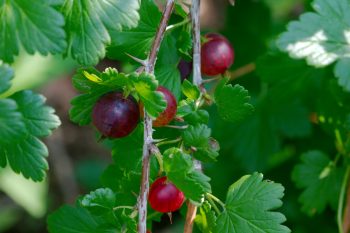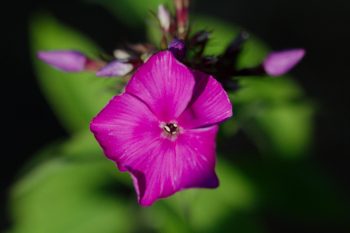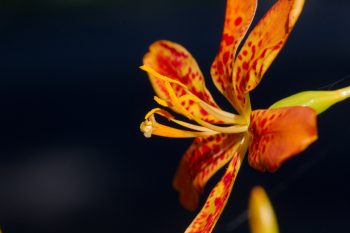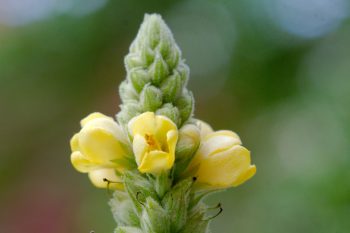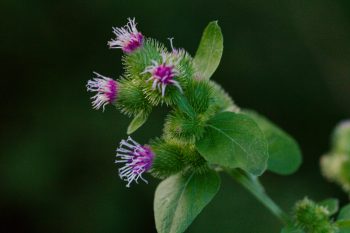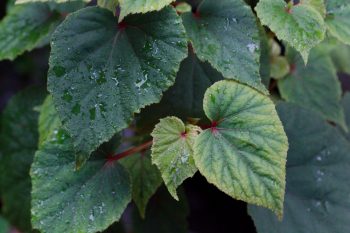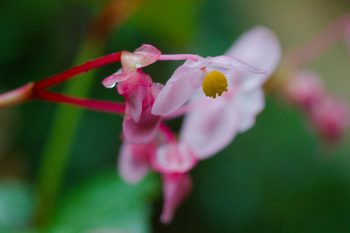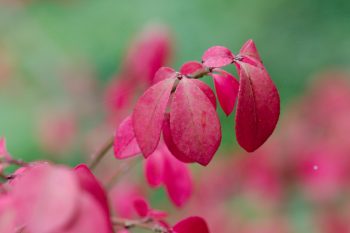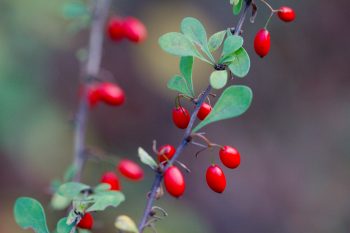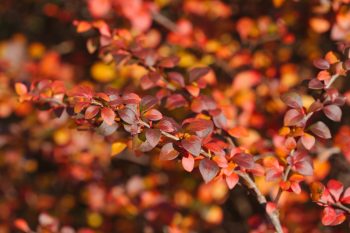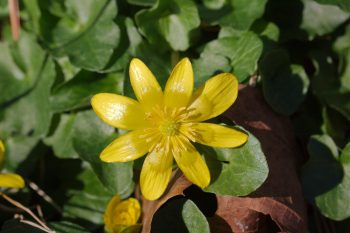It’s kousa dogwood (Cornus kousa) time in the neighborhood. These trees bloom later than the native flowering dogwood (Cornus florida) and in general have fewer problems here. They make quite handsome trees of a good size for a suburban yard. They flowers are followed by interesting fruit so they have two seasons of interest, which is nice. They also have interesting bark. The main thing, though, is that they aren’t killed by dogwood anthracnose, which is pretty hard on the C. florida trees. C. kousa is also a bit hardier, although that’s not a real issue here. But the disease problem really is.
Tagged With: Non-Native Plant
Kousa Dogwood
Allium moly (Golden Garlic)
I really should plant more of this as well as other ornamental onions. This is Allium moly, often called golden garlic, and it’s a lovely little bulb, blooming later than many of the spring bulbs. Its flowers are smaller than daffodils but it makes up for that by being one of the few things in bloom right now. In theory it spreads and needs to be controlled when growing in ideal conditions. Clearly that’s not what it has here, but it seems happy enough. Another Allium that I’ve had but don’t now is Allium caeruleum, which has pale blue flowers. I think I’ll order some of that, too, this fall, along with a bunch more deffodils.
Dianthus armeria (Deptford Pink)
This is a pretty little flower that’s starting to appear in our garden. It is Dianthus armeria, the so-called Deptford Pink, native to Europe and not naturalized over much of North America. It is an annual or biennial and grows between two and three feet tall with very thin stems topped by these lovely little pink flowers, which are about a centimeter across. It self seeds pretty well but isn’t aggressive enough to be a problem at least in our garden. Most of those we have are growing in containers on the driveway or around that area.
Mountain Bluet (Centaurea montana)
The mountain bluet (Centaurea montana), also known as perennial cornflower or perennial bachelor’s button, has a pretty, blue flower and does well in the perennial border. Dorothy and three of her housemates drove down late yesterday and today we took a drive out to Rocklands Farm Winery. They have just reopened and it was really nice to be out. Actually, we spent most of our time there visiting with Greg and Janis, which I really enjoyed. This flower is in Janis’ garden and I took it as we ate our lunches and got caught up with what everyone is doing. For information on Rocklands, see https://www.rocklandsfarmmd.com/.
Day Lily
The day lilies are starting to bloom. These are descendants from some we dug up in the woods of Pennsylvania, near our property. They are growing around what used to be a homestead, many years ago. There is a hole in the ground with the remains of stone walls and the base of a chimney. Around that are orange day lilies (Hemerocallis fulva) and periwinkle (Vinca minor) growing in great profusion. It’s in the shade as trees have grown up over it and in consequence the day lilies don’t bloom as well as they might, but we took a few home and planted them in the sun, where they bloomed quite happily. That was at our old house and we dug up and brought some of those with us here, where they continue to give a great show every year.
Euphorbia amygdaloides subsp. robbiae (Wood Spurge)
I took a few more pictures of plants on Cathy’s work table today. This one is a spurge called Euphorbia amygdaloides subsp. robbiae, also known as Robb’s wood spurge. It’s a nice combination of greens and yellows and something nice for the herbaceous border. The Euphorbia genus has something like 2,000 species and they range from small annual plants to trees and there are species from many parts of the world This one isn’t native to North America, but I’m not bothered by that. One thing you want to be careful of with these plants is their milky sap, which is poisonous if ingested and a skin irritant.
Ripe Gooseberries
The gooseberries (Ribes uva-crispa) are just about ripe. The squerrals are eating them as they ripen up and I don’t think we’re actually going to get much of a harvest. That’s our own fault, because we haven’t protected them and aren’t going out each morning to pick them as they ripen up. I don’t mind, terribly, although I have been picking and eating them when I do go out. They are just the right combination of sweet and tart. If I had a bit of land and used some of it for vegetable gardening, I think I’d plant a row of these and put a net over them. I might put a net over this one next year, although it’s against the fence and that might make it tricky.
Stock Photo
Over the years I’ve thought about selling photos as stock but I never really got into it. I’m not really sure if I’d actually make any money at it. I sort of doubt it, honestly. I know that now and then I get a reasonably good photo and I certainly enjoy both taking and looking at them. But whether they are actually suitable for stock is another matter. And of course it isn’t just that. They would have to be found among the hundreds of thousands of other stock photos. I’m sure there are ways to increase your chances but I’m not sure I care enough. So, I’ll just stick to what I do and occasionally post a photo with an attempt at a clever title. This is stock, Matthiola incana.
Iris domestica (Blackberry Lily)
The blackberry lily (Iris domestica, formerly known as Belamcanda chinensis, has beautiful, bright orange flowers above an attractive fan of sword-shaped leaves. It spreads slowly into clumps but mostly spreads by seed, which are distributed both by birds and by wives who really like it in our garden. I first collected seeds in South Carolina many, many years ago and we’ve had it around ever since. We have quite a few at this point and we may be reaching the time when a few of them need to be pulled up (but I’m not sure Cathy’s ready for that yet). They are native from the Himalayas to the Russian far east but do very well here. I like the lighting in this. The bloom is in full sun and the background is the pavement of our street in shadow.
Verbascum thapsus (Common Mullein)
This is the tip of a mullein stalk growing up close to the front of our house. It’s not really in a place I’d choose to plant it, but I left it there for Cathy. She really likes it and we have a fair amount in the hawthorn bed that has become something of a Mediterranean garden this year. It’s funny to hear so many people praise this plant as something the native Americans used medicinally. It may be true, but that only happened after it was introduced from Europe, as it isn’t a native American itself. It’s quite hardy (USDA Zones 3 to 9) and is quite happy in dry, otherwise barren places. This part of our yard really dries out in the summer and is currently rock hard. But along with the Verbascum we have Verbena bonariensis (tall verbena), Lavandula stoechas (Spanish lavender), and Salvia rosmarinus (rosemary), which all do well in rather severe conditions and in fact don’t like being waterlogged.
Tiger Lily (Lilium Lancifolium)
This won’t be the only photo I post of these, I suspect. They are starting to bloom and are already quite spectacular but when they really get into full bloom, with 20 or more flowers per stem, they are amazing. The seem to deal pretty well with the sweltering heat we’ve had and the occasional downpour. The biggest threat to them, actually, is deer, which will come in and eat them. We’ve been fortunate this year and only a few stems have been cut off (and that may be rabbits). We have them in a few places around the yard but the most conspicuous are in the front, right out near the road, where there used to be a large oak tree (until it died and the county cut it down).
Cichorium intybus (Chicory)
It wasn’t so hot today, although relative humidity was near 100%. Cathy and I went out for a walk at the former Redgate Golf Course, now Redgate Park. We saw a pair of white-tailed deer (a mother and fawn) as well as a few different wildflowers. This is a pretty common one, an import from the old world, but still a pretty flower. The others that I photographed were also non-natives. There was the Asiatic dayflower (Commelia communis), which has two white petal-like structures above the flower, and moth mullein (Verbascum blattaria), a pretty, little, white flower with a magenta throat and stamens. We also went to Rockville Cemetery, where we saw another fawn, and then Croydon Nature Center before returning home.
Arctium minus (Common Burdock)
Cathy and I went for a walk this evening. After yesterday’s rain it was cooler. Not quite cool enough to be really pleasant and still quite humid, but so much better than it’s been that we had to get out. There’s one place we walk by where the park comes right up to the road and I took this photo of common burdock (Arctium minus) along the edge of the woods. It’s a biennial native to Europe but pretty well established as a common weed here now. It has burrs that stick to fur and clothing, which helps it to spread.
Begonia grandis (Hardy Begonia)
Cathy has this hardy begonia (Begonia grandis) growing a few places around the house. It really seems to like the relatively shady area around our front door, which gets a little morning sun but that’s it. And even that is filtered through the foundation planting. It seems particularly happy this year, with the amount of rain we’ve had. It’s just coming into bloom, with its delicate and interestingly shaped, pink flowers. But I think it’s worth having just the leaves. We have a few little seedlings that Cathy has collected and she will try to get a few established in new places.
Begonia grandis (Hardy Begonia)
I had a picture of the leaves of this Hardy Begonia (Begonia grandis) earlier this month. Now it’s in bloom and adding a little brightness to the shady spot outside our front door. It’s a great plant to have and looks like it shouldn’t be sturdy enough to survive our winters but it does and it actually does quite well. It won’t grow well too far to our south because of the heat of summer or too far to the north because of the cold winters, but here it’s quite reliable. Highly recommended.
Burning Bush (Euonymus alatus)
As a landscape plant, burning bush (Euonymus alatus) can be quite striking. I hesitate to ever recommend it. It is an invasive and its use is actively discouraged in many areas (and even banned in Massachusetts, I believe). It’s a native of northeastern Asia and is naturalized over much of eastern North America. The plant we have is in a pot, which helps keep it small, although I’m not really sure I want even that much in my yard. Not that getting rid of ours is going to make much difference, as this is grown all over our area and the cat is already out of the bag.
Torenia ‘Summer Wave’
We’ve grown Torenia fournieri before but I don’t think it has ever done as well as it did this year. We have a couple of them in containers on the back patio and they have been in constant bloom all summer and will probably not stop until we get a killing frost. They are also known a wishbone flower because the stamens join to form a shape similar to the wishbone of a chicken. This one is a variety called ‘Summer Wave’. Ours got a bit of sun but they are also really good for shade. You better believe we’re going to get this again next year.
Ficaria verna
Dorothy, Cathy, and I walked on the Seneca Greenway Trail this afternoon, parking where MD 28 crosses Seneca Creek and walking downstream. We only saw a few other people and it was a very pleasant walk. It’s relatively flat, with only a few ups and downs to deal with. The birds were out in force and we heard them all around, although we weren’t stopping to see them so much and didn’t really get very close to any. I did stop to take a few photos, including of this fig buttercup, also known as lesser celandine. It was formerly classified as Ranunculus ficaria but is now Ficaria verna. It’s an invasive, non-native species that grows in many of our wetlands.

